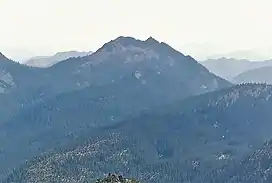| Copper Mountain | |
|---|---|
 North aspect, from Mt. Skokomish | |
| Highest point | |
| Elevation | 5,425 ft (1,654 m)[1] |
| Prominence | 1,345 ft (410 m)[2] |
| Parent peak | Mount Ellinor (5,940 ft)[3] |
| Isolation | 1.36 mi (2.19 km)[3] |
| Coordinates | 47°31′22″N 123°17′47″W / 47.5226428°N 123.2963231°W[4] |
| Geography | |
 Copper Mountain Location of Copper Mountain in Washington  Copper Mountain Copper Mountain (the United States) | |
| Location | Olympic National Park Mason County, Washington, US |
| Parent range | Olympic Mountains |
| Topo map | USGS Mount Skokomish |
| Geology | |
| Age of rock | Eocene |
| Climbing | |
| Easiest route | class 2 via Wagonwheel Lake[2] |
Copper Mountain is a 5,425-foot (1,654 m) mountain summit located in the southeast portion of the Olympic Mountains, in Mason County of Washington state.[4] It is situated on the boundary shared by Daniel J. Evans Wilderness and Mount Skokomish Wilderness, as well as the shared common border of Olympic National Park with Olympic National Forest. The nearest higher neighbor is Mount Ellinor, 1.67 miles (2.69 km) to the east.[5] Wagonwheel Lake lies immediately north of the peak. Topographic relief is significant as the summit rises nearly 4,700 feet (1,400 m) above the Staircase Ranger Station at Lake Cushman in approximately 1.5 miles (2.4 km). Precipitation runoff from the mountain drains north into the Hamma Hamma River, and south into the North Fork Skokomish River, thence Lake Cushman.
Climate
Copper Mountain is located in the marine west coast climate zone of western North America.[6] Most weather fronts originate in the Pacific Ocean, and travel east toward the Olympic Mountains. As fronts approach, they are forced upward by the peaks of the Olympic Range, causing them to drop their moisture in the form of rain or snowfall (Orographic lift). As a result, the Olympics experience high precipitation, especially during the winter months. During winter months, weather is usually cloudy, but due to high pressure systems over the Pacific Ocean that intensify during summer months, there is often little or no cloud cover during the summer. Because of maritime influence, snow tends to be wet and heavy, resulting in avalanche danger. The months April through October offer the most favorable weather for climbing or viewing.[2]
Etymology
The mountain was named on July 7, 1890, by Lieutenant Joseph P. O'Neil (1863–1938), United States Army officer who led the 1885 and 1890 O'Neil Expeditions to explore the interior of the Olympic Mountains.[1] Earlier that same year, prospectors had discovered copper ore on the mountain.
Geology
The Olympic Mountains are composed of obducted clastic wedge material and oceanic crust, primarily Eocene sandstone, turbidite, and basaltic oceanic crust.[7] The mountains were sculpted during the Pleistocene era by erosion and glaciers advancing and retreating multiple times.
Gallery
See also
References
- 1 2 Olympic Mountain Rescue, Olympic Mountains: A Climbing Guide, 4th Edition, 2006, Mountaineers Books, ISBN 9780898862065, page 73.
- 1 2 3 Copper Mountain, climbersguideolympics.com
- 1 2 "Copper Mountain - 5,425' WA". listsofjohn.com. Retrieved 2022-02-07.
- 1 2 "Copper Mountain". Geographic Names Information System. United States Geological Survey, United States Department of the Interior. Retrieved 2022-02-07.
- ↑ "Copper Mountain, Washington". Peakbagger.com.
- ↑ Peel, M. C.; Finlayson, B. L.; McMahon, T. A. (2007). "Updated world map of the Köppen−Geiger climate classification". Hydrol. Earth Syst. Sci. 11. ISSN 1027-5606.
- ↑ Alt, D.D.; Hyndman, D.W. (1984). Roadside Geology of Washington. pp. 249–259. ISBN 0-87842-160-2.
External links
- "Olympic National Park". National Park Service.
- Mount Skokomish Wilderness U.S. Forest Service
- Copper Mountain / East Ridge: The Mountaineers



